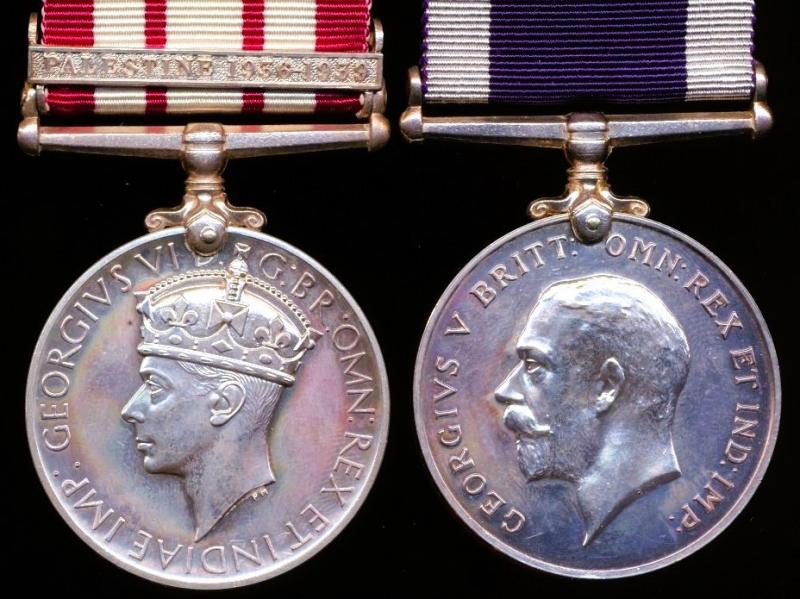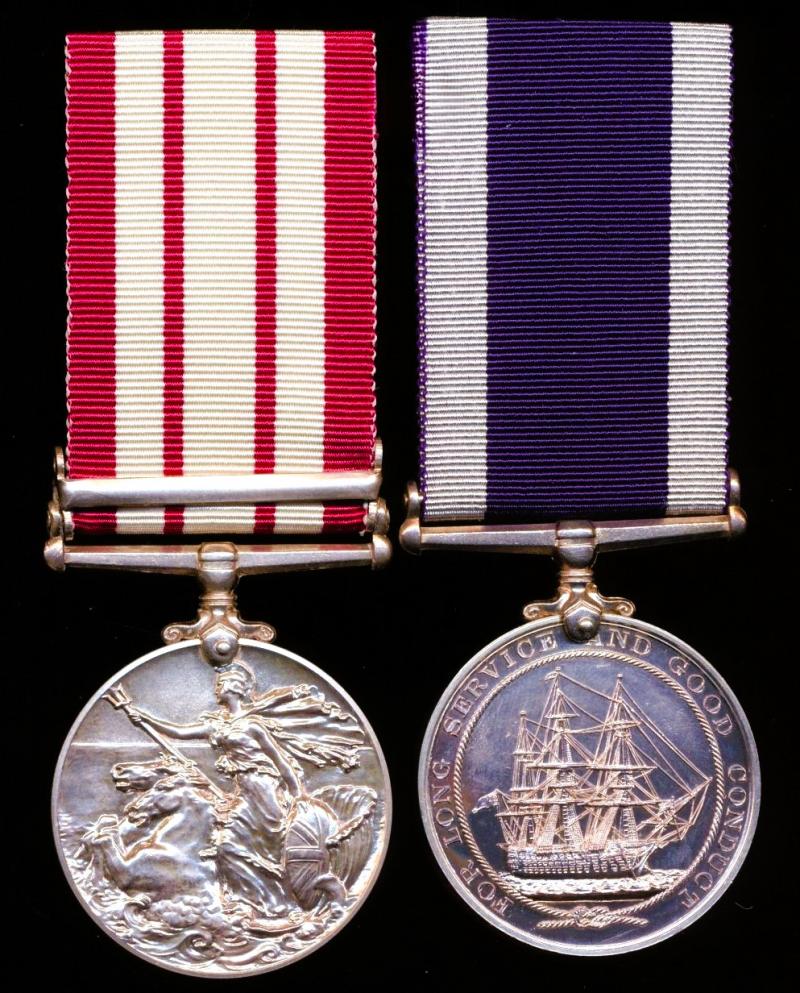A group to a Petty Officer Cook who served in Palestine, was present at Dunkirk & aboard the Command Ship for the Dieppe Raid who was witness to sinking of an enemy U-Boat: Petty Officer Cook, Albert Edward Paul, Royal Navy late H.M.S. Calpe
- NGSM 1915-62. 'Palestine 1936-39' (M.36591 A. E. Paul, P.O.Ck. R.N.)
- Naval LS&GC. GVI issue (M.36591 A. E. Paul. L. Ck. H.M.S. Lupin.)
Note: The Naval LS&GC with minor official correction to surname - and fairly typical thus for this particular medal issue
Medals and clasp verification: Both medals and clasp confirmed as entitled per entries on the recipients extant service sheets (held and accessible at The National Archives), and Admiralty medal roll for the Naval LS&GC, per references cited below. Note: NGS 'Palestine' & Second World War medal rolls are not yet in the public domain, however basic qualification for the below campaign medals can be derived from entries of ship's names in the recipients extant 'Service Sheet':
- NGSM with clasp: Shown as entitled on service sheet, and known to be an award while serving on H.M.S. Garland on which recipient served 12/07/38 - 31/12/39
- The 1939-45 Star. No clasp
- The Atlantic Star. No clasp
- The Africa Star. With clasp 'North Africa 1942-43
- The Italy Star
- War Medal
- Naval Long Service & Good Conduct Medal: ADM 171/151 issued to named to H.M.S. Lupin. Service sheet shows 'Traced' 17 September 1936
H.M.S. Wolsey (01/01/40 - 28/11/41): On 21 January 1940, her pennant number was changed to L02, and she was selected for service in home waters. She proceeded from Malta to Gibraltar, where on 29 January 1940, she and the sloop Lowestoft began a voyage to Liverpool as the escort of Convoy HG 17F. Reinforced during the voyage by the sloop Sandwich on, 31 January and by the destroyers Broke and Winchelsea from 4 to 5 February, Wolsey and Lowestoft escorted the convoy until its arrival at Liverpool on 7 February 1940. After her arrival at Liverpool, Wolsey was assigned to Western Approaches Command and began convoy escort and patrol duty in the Western Approaches. On 10 May 1940, she was transferred to the Commander-in-Chief, Dover to support Allied military operations during the German offensive into France, Luxembourg, Belgium, and the Netherlands that began that month. On 13 May, she and the destroyers Boreas, Keith, and Wivern escorted a convoy bringing reinforcements from the United Kingdom for French antiaircraft defenses in ports along the English Channel, and later the same day embarked demolition parties and carried them to Le Havre, France, to destroy port facilities there before advancing German Army forces captured them. On 16 May, she and the destroyer Vimiera bombarded German ground forces at Escault in Offrethun, France, and Wolsey again bombarded Escault on 17 May. On 22 May she and the destroyer Vimy escorted the cargo ship City of Christchurch as City of Christchurch carried heavy motor vehicles and tanks from Southampton to Calais, France.6 On 23 May, Wolsey embarked a demolition party for Le Havre and then steamed to Calais to assist in the evacuation of British citizens before returning to Dover. On 25 May, she and the destroyer Wolfhound engaged German 150-mm (5.9-inch) howitzers in defence of the evacuation of Calais
Service at Dunkirk (Operation Dynamo): On 26 May 1940, Wolsey was assigned to Operation Dynamo, the evacuation of Allied troops from the beaches at Dunkirk, France. She embarked evacuees from small craft offshore on 27 May and disembarked 102 evacuated troops at Dover on 28 May. She delivered another 315 troops from Dunkirk at Dover on 29 May. On 30 May, she made two evacuation voyages, carrying 616 troops to Dover on the first one and 1,065 on the second. On 31 May while at Dunkirk, she suffered damage when a fire broke out in her degaussing equipment and in a collision with a merchant ship, but despite her damage she deployed offshore to serve as a wireless transmitter link between Dunkirk and Dover and later in the day landed 425 evacuated troops at Dover. She carried another 535 troops from Dunkirk to Dover on 1 June before being withdrawn from evacuation operations later in the day for repairs.
Wolsey proceeded to Portsmouth on 2 June 1940, where she entered the Royal Navy Dockyard on 3 June for repairs. Upon their completion, she began convoy defence operations and anti-invasion patrols in the North Sea in July 1940. In August 1940, she returned to convoy escort duty with the Western Approaches Command. In January 1941, Wolsey was transferred to the Rosyth Escort Force based at Rosyth, Scotland, to escort coastal convoys in the North Sea and Northwestern Approaches
H.M.S. Calpe (29/11/41- 23/01/44): In 1942 'Calpe' sailed under the Spanish Ensign as she approached St Jean de Luz. To keep up the pretense, all the crew remained below deck. It was not until before the bombardment took place on 4–5 April that the British Ensign replaced the Spanish jack. On 28 July, Calpe and HMS Cottesmore shelled and sunk an enemy 'Kriegsmarine' vessel, vide Vorpostenboot V 202 Hermann Bösch in the English Channel off La Hague, Manche, France
Dieppe Raid: 18 and 19 August 1942 Calpe was involved in the Dieppe Raid. Her primary function was to act as the command ship for the raid and was used by Major-General Roberts (OC, 2nd Canadian Infantry Division) and Captain John Hugues-Hallet RN (Naval Commander for the raid). She acted as a hospital ship and sustained casualties, losing nearly a quarter of the crew. Despite this, Calpe managed to take on and care for 278 casualties
Operation Torch & Sinking of U-Boat: In October 1942, Calpe was included in the ships that would take part in action in North Africa. She was sent to guard a convoy to her namesake Gibraltar. In November she became part of Operation Torch as she was included in the Central Task Force for allied landings. Following the 'Torch Landings' Calpe identified the submarine U-593 in the Mediterranean, and together with USS Wainwright, managed to sink the U-boat on, 13 December 1943. Prior to its destruction and sinking, the U-boat had already sunk two sister Hunt-class destroyers, Tynedale and Holcombe that month. The captain of Wainwright, Commander Strohbehn, noted in his account that "it was a pleasure" to work with the British Warship
Albert Edward Paul, son of Thomas Paul (a Tank Rivetter) & Jane Paul (nee Foster) was a native of, Limehouse, London, England, where he was born on, 21 July 1903. By the time of the 1911 National Census for England & Wales, Albert is shown living with his widowed mother (described as a Fish Cleaner) and four older siblings, comprising 3 x sisters and 1 x brother, at the family residence located at, 57 Carr Street, Limehouse, London, England. Albert was 19 years of age and had been employed as a 'Labourer', when he joined the Royal Navy on, 29 July 1921. Albert had contracted for a 12 years engagement, and on the day of his enlistment he was rated as 'Assistant Cook', Evidently Albert was a model sailor, as he was raised 'Cook' rate on and served long postings aboard the battleships H.M.S. Royal Sovereign (1923-25) & H.M.S. Ramillies (1927-29). Albert served for several years on the Mediterranean Station, where he was based from H.M.S. St. Angelo, the Royal Naval barracks at Malta Colony, and from where he served aboard the destroyer, H.M.S. Garland (1938-39) including Palestine service. On 1 January 1940, he joined the destroyer H.M.S. Wolsey, which ship served on convoy duty and was present at Dunkirk throughout Operation Dynamo. From 29 November 1941, he then served aboard the destroyer H.M.S. Calpe. during which service he was present on the 'Command Ship' during the ill-fated 'Dieppe Raid' where 'Calpe' suffered appalling casualties. Albert was also present on 'Calpe' when she sunk a German U-Boat. From January 1944 to September 1945, Albert served briefly at the Royal Navy shore base H.M.S. Hannibal, at Algiers, before being transferred in March 1944 for service in Home Waters, his service sheet showing that he served variously both ashore and afloat during the last 14 months of the Second World War. Albert Edward Paul is recorded on his service sheet as having died on 7 January 1951. At the time of his death he had been residing at, 62 Grove Lane, Ipswich, Suffolk, England. His estate was valued at GBP 782 & 17 Shillings, and was left to his wife, Winifred Ellen Paul
Condition: About EF
Code: 24334
325.00 GBP







